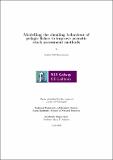| dc.description.abstract | Creating a model of collective behaviours, such as a fish shoal, requires understanding the movements and interactions of the individuals within. Individual-based models (IBMs), which consist of autonomous agents interacting in a model space, have been used extensively in collective behaviour research, including investigating how fish engage with each other and their environment. Testing these models with data gathered from the lab or the field can be difficult, however. By extension, very few modelling studies have aimed to address real-world questions such as environmental degradation. As shoaling behaviour is a source of variability in the acoustic survey methods that underpin many fisheries population estimates, IBMs can be used to explore how intrinsic behavioural factors and extrinsic environmental factors interact to affect shoal shape and density, and therefore stock assessments and sustainable fisheries quotas.
Chapter 2 reviews the role of behaviour in acoustic sampling, shoaling IBMs, and the potential for improvements to fisheries sustainability by exploring density estimation with an IBM. Chapter 3 is an example of how a simple shoaling IBM based on the three-parameter model of coherence with local neighbours, separation at a close distance, and alignment with neighbours, built to be flexible and scalable in Python, can be validated with approximate Bayesian computation (ABC). ABC, while commonly used to validate IBMs, has not previously been applied to a shoaling model. In ABC, statistical indicators of shoaling behaviour collected from the model and from video of a small shoal of fish are used to narrow the prior distribution of parameter values for the model. Four of the six parameters were significantly narrowed. Cross-validation tests indicated, however, that the model could be improved by determining more informative statistical indicators. The overall IBM/ABC framework, as demonstrated in Chapter 3, is flexible and iterative, well-suited to collective behaviour modelling where informative priors and a large quantity of empirical data may not be available.
Chapter 4 presents a version of the shoaling IBM in Chapter 3, reconceptualized to match the output from acoustic surveying: echograms. By determining the density from the position of each fish, rather than a statistical indicator of individual behaviour (i.e. nearest neighbour distance), ABC could be used to determine how the overall shape of a shoal changes in response to intrinsic factors, such as swimming speed, or extrinsic factors such as a thermocline or sloped substrate. Additionally, heading, which emerges from the movement vectors programmed for each individual, can be representative of the tilt angle of the fish relative to the ship. Tilt angle is an important factor in acoustic sampling, as the different tissues within a fish provide a different acoustic signal. Across a fish shoal, this can lead to high variability in the recorded backscatter and therefore biomass. Additional work is needed to develop the prior parameters, density calculations, and computational framework to simulate and assess a fish shoal on the scale of pelagic species like herring or blue whiting, but this chapter presents a novel approach to density estimation with the potential to apply the robust field of collective behaviour modelling to fisheries sustainability.
To further explore the relationship between shoaling behaviour and acoustic sampling, Chapter 5 contains a survey of acoustic experts and non-experts on their ability to identify species from echograms without contextual information. There was high agreement across both groups for simpler echograms, but low agreement for more complex ones. Overall, the expert group performed only marginally better than the non-expert group. The comments on the survey emphasized the importance of contextual information (time of day, time of year, and location) in species identification. These findings indicate that shoaling behaviour is not straight-forward or species-specific, with additional implications for attempts to automate the acoustic survey process. Overall, this thesis seeks to combine the theory behind collective behaviour with the practical need for better estimates of fish density. | en_IE |


